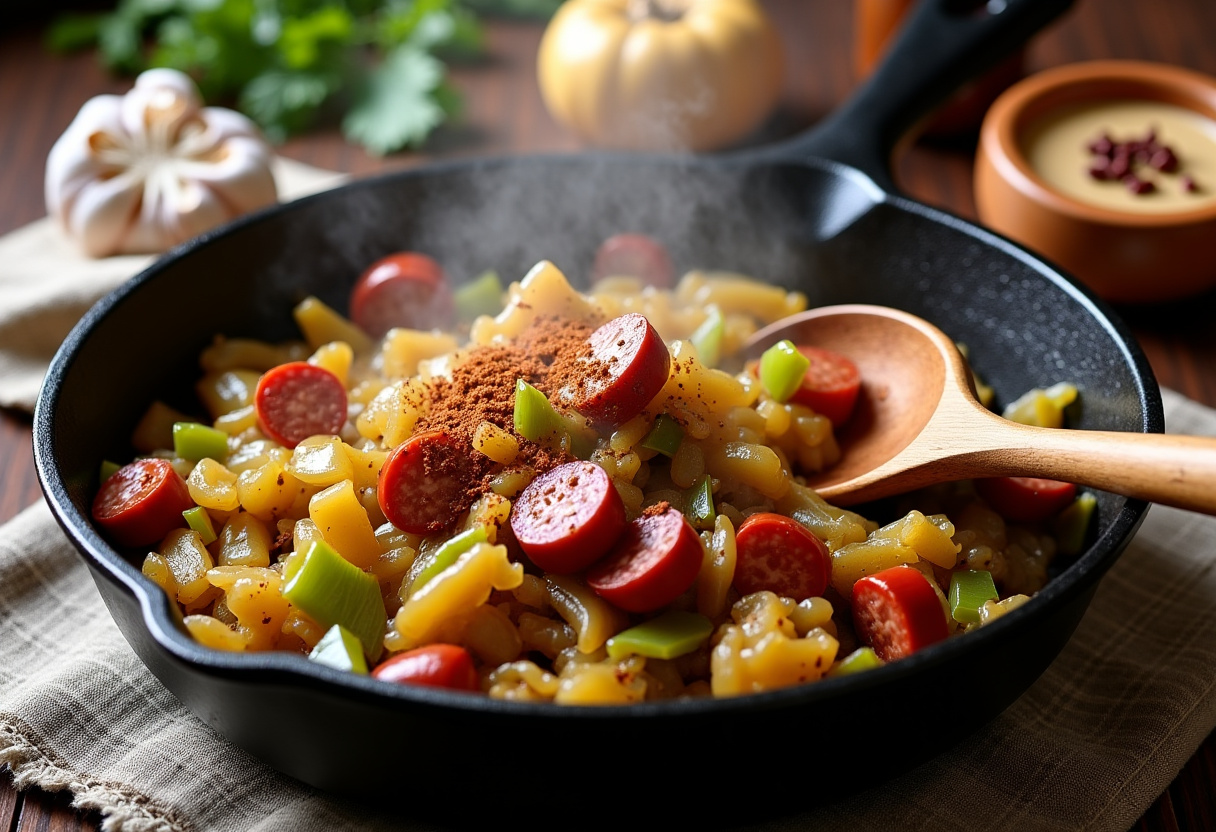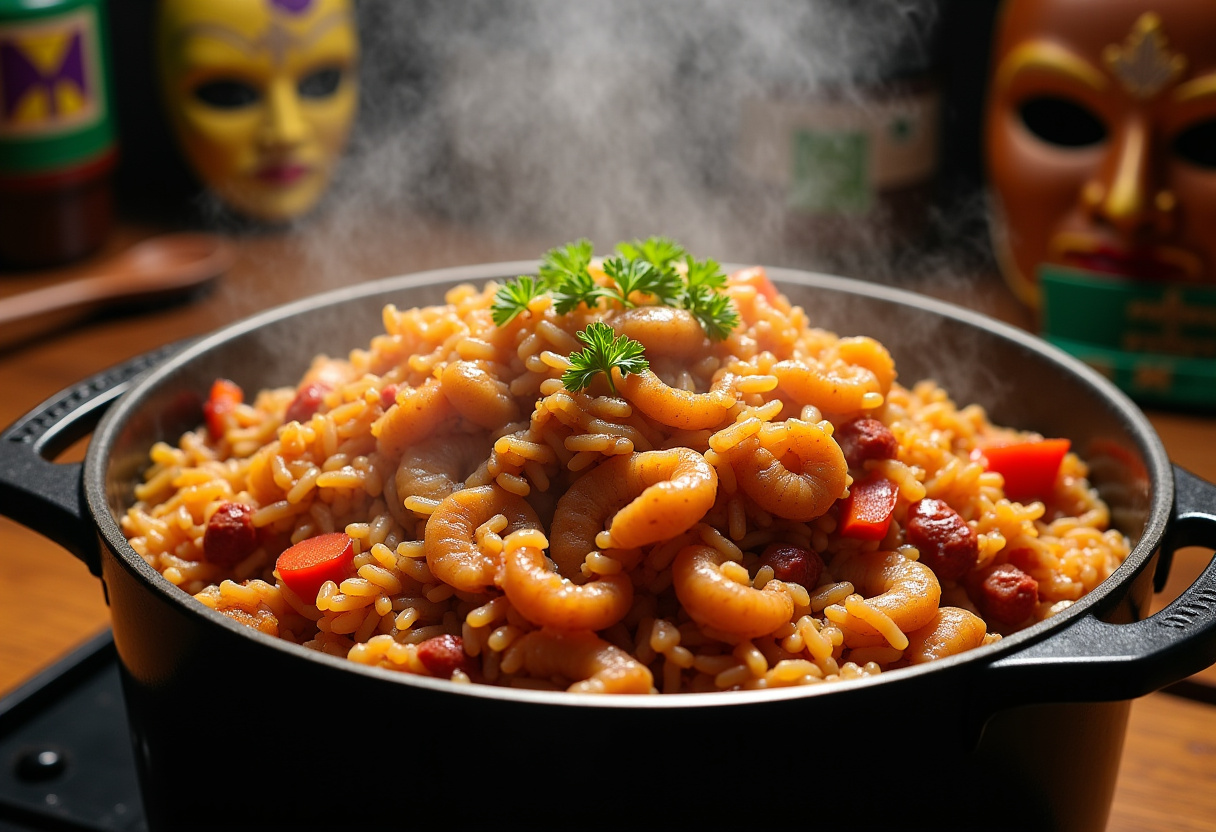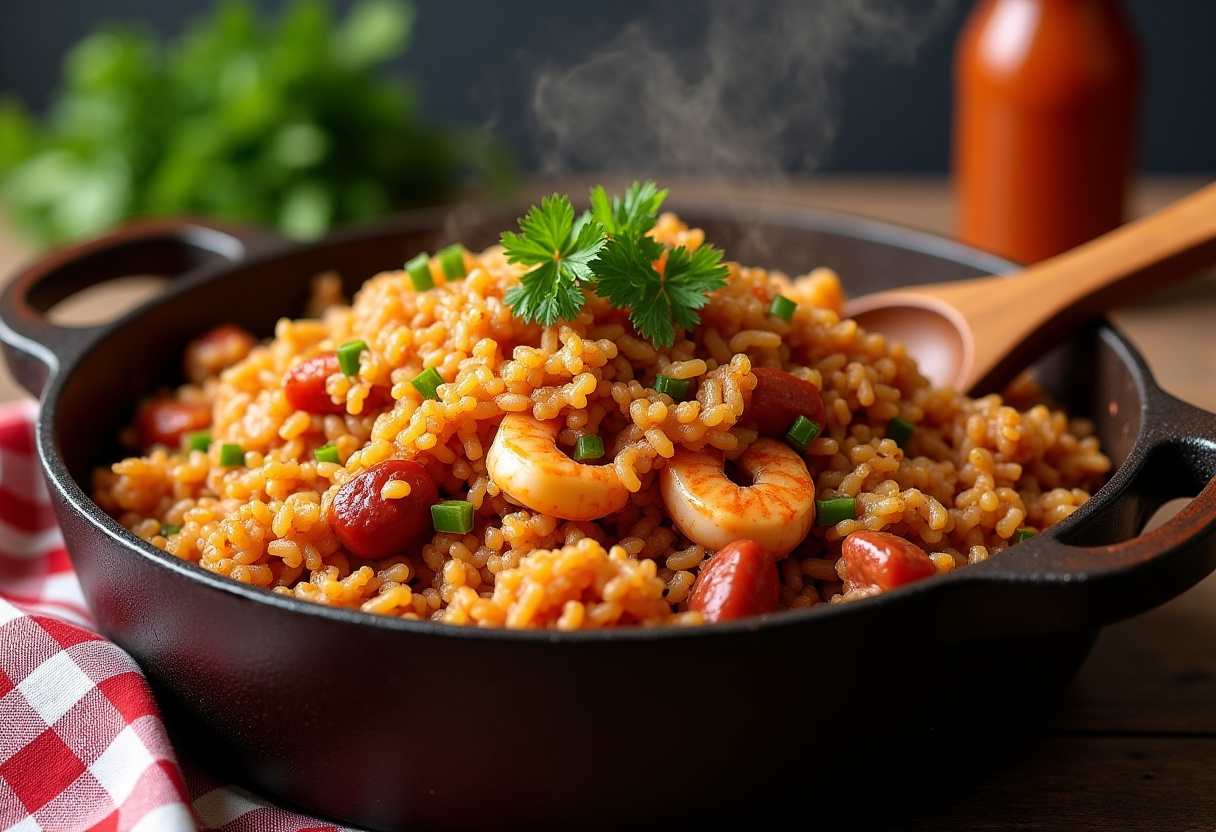Cajun Jambalaya: A Spicy, Hearty One-Pot Wonder
1. Introduction
Cajun jambalaya is more than just a dish – it’s a vibrant celebration of Louisiana’s rich culinary heritage. This quintessential Creole recipe tells the story of cultural fusion, combining French, Spanish, African, and Native American influences into one irresistible pot. The magic of authentic Cajun jambalaya lies in its perfect balance of textures and flavors: smoky andouille sausage, tender chicken, plump Gulf shrimp, and the “holy trinity” of Cajun cooking (onions, bell peppers, and celery) all mingling with perfectly seasoned rice.
Unlike its Creole cousin which includes tomatoes, traditional Cajun jambalaya gets its rich brown color from well-caramelized meats and a slow-building roux. This rustic one-pot wonder was originally created as a way to feed large groups with whatever ingredients were available, making it the ultimate comfort food for gatherings. Whether you’re hosting a Mardi Gras party, planning a cozy family dinner, or simply craving a taste of New Orleans at home, this cajun jambalaya recipe delivers authentic flavor with every satisfying bite.

2. Ingredients
To create this authentic Louisiana masterpiece, you’ll need the following ingredients. For the best results, we recommend using high-quality, fresh ingredients whenever possible:
- 1 lb andouille sausage, sliced – Look for authentic Louisiana andouille for that signature smoky flavor
- 1 lb chicken thighs, diced – Thighs stay juicier than breasts during the long cooking process
- 1 lb shrimp, peeled and deveined – Medium or large shrimp work best (21-25 count)
- 2 cups long-grain white rice – We prefer Jasmine or Basmati for their fragrance and texture
- 1 large onion, diced – Yellow onions provide the best flavor base
- 1 green bell pepper, diced – Adds sweetness and crunch
- 2 celery stalks, diced – Essential for the holy trinity flavor base
- 4 cloves garlic, minced – Fresh garlic makes all the difference
- 3 cups chicken broth – Homemade or low-sodium store-bought
- 1 can (14.5 oz) diced tomatoes – Fire-roasted add extra depth (optional for Cajun style)
- 2 tbsp Cajun seasoning – Make your own blend or use a quality store-bought mix
- 1 tsp smoked paprika – Adds that essential smoky note
- 1 tsp dried thyme – A classic Creole herb
- 1 tsp dried oregano – For earthy undertones
- 2 bay leaves – Remove before serving
- 3 tbsp vegetable oil – Or peanut oil for higher smoke point
- Salt and pepper to taste – Season in layers
- Fresh parsley and green onions for garnish – Adds freshness and color
For those looking to explore more authentic Cajun recipes, check out this excellent resource from The Spruce Eats that dives deeper into Cajun cooking techniques.
3. Instructions
Step 1: Sauté the Holy Trinity and Sausage
Begin by heating oil in a large Dutch oven or heavy-bottomed pot over medium-high heat. The heavy pot ensures even heat distribution and prevents burning. Add the sliced andouille sausage and cook until beautifully browned, about 5 minutes. This step is crucial as it renders the sausage fat which will flavor the entire dish. Remove the sausage with a slotted spoon and set aside, leaving those flavorful drippings in the pot.
Next, add the diced chicken thighs to the same pot. The chicken will absorb all those wonderful sausage flavors as it browns. Cook for about 5-7 minutes until golden brown on all sides. Remove and set aside with the sausage. Now it’s time for the holy trinity – add the onion, bell pepper, and celery to the pot. Sauté these aromatic vegetables until they soften and the onions become translucent, about 5 minutes. This creates the flavor foundation of your jambalaya. Add the minced garlic last (to prevent burning) and cook for just 1 minute until fragrant – you’ll know it’s ready when your kitchen smells incredible.

Step 2: Build the Flavor Base
Now return the browned sausage and chicken to the pot – this is where the magic really begins. Stir in the Cajun seasoning, smoked paprika, thyme, and oregano. Take a moment to toast these spices with the meats and vegetables – this quick 2-minute step intensifies their flavors dramatically. You’ll notice the aroma becoming more complex and enticing.
Add the diced tomatoes with their juices (if using) and the bay leaves. The tomatoes add acidity and sweetness that balances the rich meats. Stir well to combine all the ingredients and let this mixture simmer gently for about 5 minutes. This simmering time allows the flavors to marry and develop depth – think of it as letting the ingredients get to know each other before the rice joins the party.

Step 3: Cook the Rice
Now add the rice to the pot, stirring to coat each grain with the flavorful mixture. This coating step helps prevent the rice from becoming gummy. Pour in the chicken broth (hot broth is ideal if you have it) and bring everything to a lively boil. This initial boil is important for proper rice hydration.
Once boiling, immediately reduce the heat to low, cover tightly with a lid, and let simmer undisturbed for 20 minutes. This no-peek, no-stir rule is crucial for perfect rice texture. After 20 minutes, carefully check the rice – it should be tender and have absorbed most of the liquid. If needed, cook for another 5 minutes, but be cautious not to overcook. The rice should be moist but not mushy, with each grain distinct.

Step 4: Add the Shrimp and Finish
Gently fold in the shrimp, distributing them evenly throughout the jambalaya. Cover and cook for exactly 5 more minutes – shrimp cook quickly and will become rubbery if overcooked. You’ll know they’re done when they turn pink and opaque.
Remove from heat and let stand covered for 5 minutes – this resting period allows the flavors to settle and the rice to achieve perfect texture. Remove the bay leaves (they’ve done their job). Taste and adjust seasoning with salt and pepper if needed. The final flourish? A generous sprinkle of chopped fresh parsley and green onions for brightness and color contrast.

4. Tips for Perfect Cajun Jambalaya
- Use authentic andouille sausage – The smokiness and spice level of real Louisiana andouille can’t be replicated with regular smoked sausage. If you can’t find it locally, several reputable online retailers ship authentic Cajun products nationwide.
- Don’t rush the holy trinity – Taking time to properly sauté the onions, bell peppers, and celery develops their sweetness and creates the flavor foundation of your dish.
- Toast your spices – That brief cooking of the spices before adding liquids awakens their essential oils and intensifies their flavor.
- Resist stirring the rice – This is the hardest part for many cooks, but disturbing the rice while it cooks releases starch and creates a gummy texture.
- Adjust heat carefully – After bringing to a boil, reduce to the lowest possible simmer to prevent burning on the bottom.
- For extra heat – Add a pinch of cayenne pepper, some chopped jalapeños, or a few dashes of your favorite hot sauce with the spices.
- Rice matters – Long-grain rice holds up best. Avoid parboiled or instant rice which will turn mushy.
5. Serving Suggestions
This hearty cajun jambalaya is substantial enough to stand alone as a complete meal, but these accompaniments can elevate your dining experience:
- Crusty French bread – Essential for sopping up every last bit of flavorful sauce. A warm baguette from your local bakery is perfect.
- A simple green salad – The crisp freshness balances the richness. Try mixed greens with a bright vinaigrette.
- Cornbread or hushpuppies – For a true Southern experience, serve with honey butter.
- Beverage pairings – A cold lager or pale ale cuts through the spice beautifully. For non-alcoholic options, sweet iced tea or lemonade work wonderfully.
- Hot sauce on the side – Let guests adjust their own heat level with Crystal, Tabasco, or your favorite brand.
For more inspiring dinner ideas that pair well with jambalaya, visit our collection at dinnerrecipesidea.com.
6. Storage and Reheating
Store leftover jambalaya in an airtight container in the refrigerator for up to 3 days. The flavors actually improve after a day as the spices continue to meld. To reheat:
- Stovetop method (preferred): Add a splash of water or broth (about 2 tbsp per serving) and warm gently over medium-low heat, stirring occasionally. Cover for the first few minutes to help steam the rice back to life.
- Microwave method: Place in a microwave-safe dish, add a tablespoon of water, cover loosely, and heat in 1-minute intervals, stirring between each.
You can freeze jambalaya for up to 2 months. Portion it into freezer-safe containers for easy meals. Thaw overnight in the refrigerator before reheating. Note that the shrimp texture may change slightly after freezing.
7. Variations
One of the beauties of jambalaya is its adaptability. Here are some delicious variations to try:
- Seafood Jambalaya – Add crawfish tails, lump crab meat, or oysters along with the shrimp for a coastal twist.
- Vegetarian Jambalaya – Substitute meat with portobello mushrooms, eggplant, okra, and extra beans. Use vegetable broth.
- Spicier Version – Double the Cajun seasoning or add chopped jalapeños or serrano peppers with the holy trinity.
- Creole Jambalaya – Include tomatoes for a redder, slightly sweeter version more common in New Orleans.
- Game Meat Jambalaya – Substitute duck, rabbit, or even alligator for the chicken for a truly authentic Cajun experience.
- Smokier Version – Add a teaspoon of liquid smoke or some chopped smoked ham with the meats.
8. Frequently Asked Questions
What’s the real difference between Cajun and Creole jambalaya?
Cajun jambalaya (country style) is typically brown in color from well-caramelized meats and usually omits tomatoes. Creole jambalaya (city style) includes tomatoes for a redder hue and often has a more refined flavor profile. Both are delicious – it comes down to personal preference!
Can I use different types of rice?
While long-grain white rice is traditional, you can experiment with brown rice (increase liquid and cooking time) or even wild rice blends for extra texture. Avoid short-grain or sushi rice which becomes too sticky.
My jambalaya turned out too wet/mushy. What went wrong?
This usually happens from too much liquid, stirring during cooking, or insufficient cooking time. Next time, measure liquids carefully, resist stirring, and ensure your simmer is active enough to evaporate excess moisture.
Can I make jambalaya in advance for a party?
Absolutely! Prepare up through the rice cooking step, then cool and refrigerate. About 30 minutes before serving, reheat gently on the stove, then add the shrimp to finish. This prevents the shrimp from overcooking.
What if I can’t find andouille sausage?
While not quite the same, you can substitute another smoked sausage like kielbasa and add extra smoked paprika and cayenne to approximate the flavor. Better yet, order authentic andouille online from a Louisiana supplier.
9. Conclusion
This authentic cajun jambalaya recipe is more than just a meal – it’s an edible celebration of Louisiana’s vibrant culture. With its perfect balance of spicy sausage, tender chicken, plump shrimp, and seasoned rice, each bite tells a story of culinary tradition and regional pride. The beauty of jambalaya lies in its versatility and ability to bring people together around the table.
Whether you’re cooking for a festive crowd, meal prepping for the week, or simply treating yourself to a taste of the bayou, this one-pot wonder delivers big flavor with minimal cleanup. Don’t be surprised if this becomes your new favorite comfort food – it’s that good! As they say in Cajun country, “Laissez les bons temps rouler” (let the good times roll) with this soul-satisfying taste of Southern hospitality.
For more delicious one-pot meals and dinner inspiration, explore our collection of recipes at dinnerrecipesidea.com, where we bring global flavors to your home kitchen.








No comment